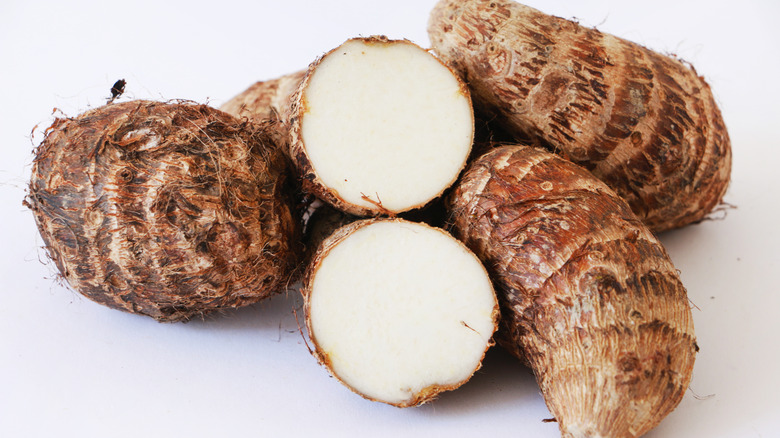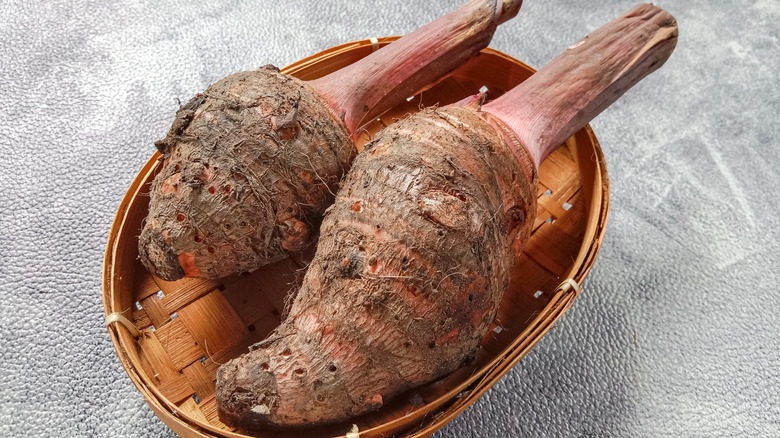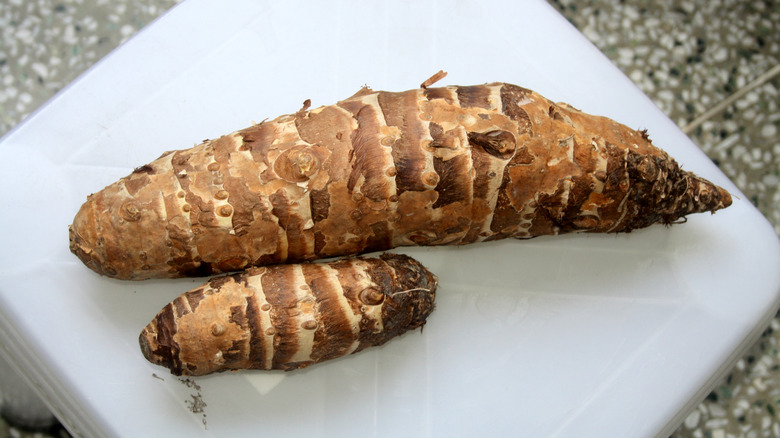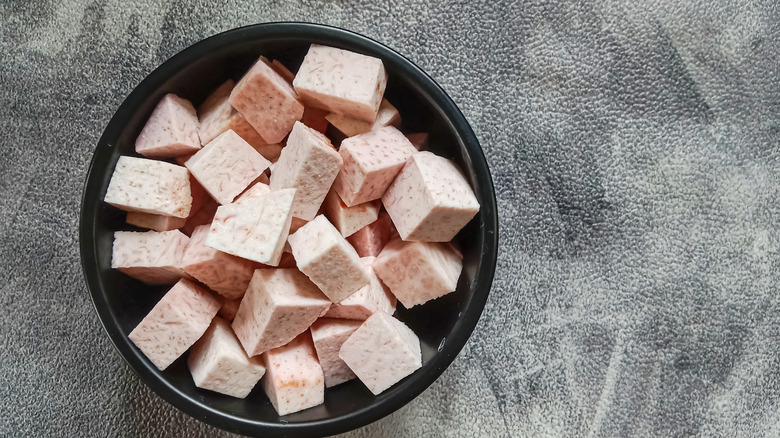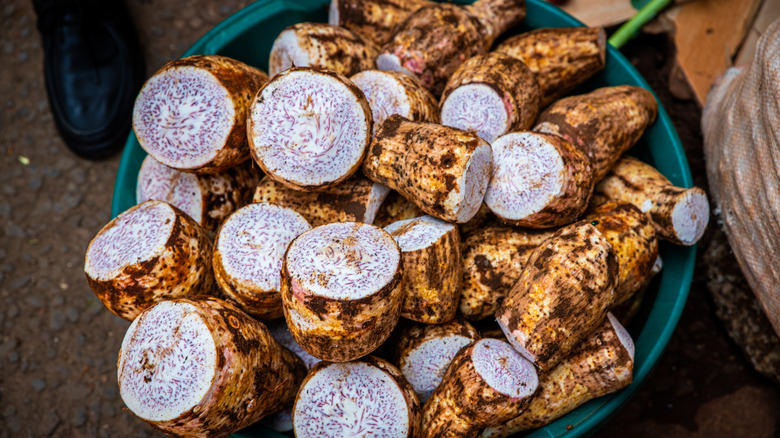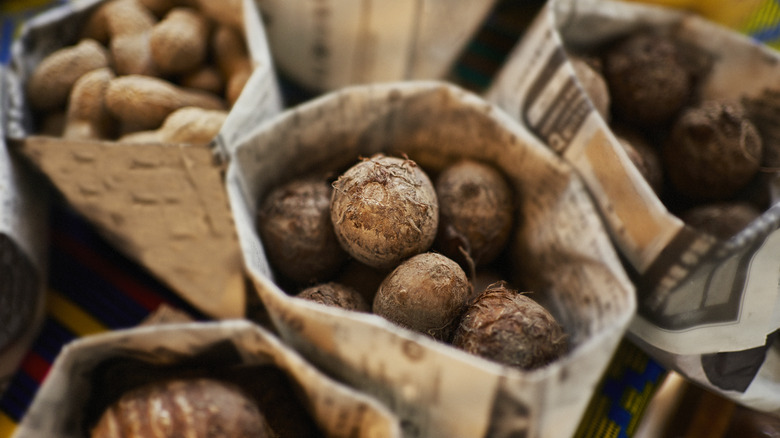What Is Taro? How To Tell The Big From The Small Version And When To Use Each
If you've ever had a creamy purple drink at a boba shop or sampled a bowl of poi alongside your kalua pork at a luau, you've tasted one of the world's first cultivated plants: taro. This starchy root vegetable has been grown for over 5,000 years and takes a multitude of forms in the cooking traditions of Southeast Asia, from sweet and creamy to crunchy and savory. It's also a staple of traditional Hawaiian cuisine, where its dense, starchy texture and mild flavor scratch the same itch that potatoes do in European cooking.
And while long unnoticed by North American diners outside the Asian Pacific diaspora, taro is now attracting the attention of those exploring plant-based cooking. It's not only affordable and easy to find, it's high in fiber and nutrients. Even better, its mild, buttery flavor makes it an easy sell for those with timid palates. But shopping for and handling taro can seem confusing if you're not familiar with it. For one, it comes in two varieties that seem quite different from each other –- does that matter? And how are you supposed to prepare the thick-skinned, bumpy roots for cooking? Here, we break down the basics and make it easy for you to shop for and cook taro with confidence.
What is taro?
The term taro is used for a range of related starchy root vegetables, but the one types you're most likely to encounter are varieties of true taro, a major food crop in Asia, Africa, and the Pacific islands. Residents of these islands appreciate taro as a food crop for its resilience — the starchy roots, sheltered safely underground, can withstand heavy storms that decimate above-ground crops. (While standardly referred to as roots, the edible underground parts of the taro plant are technically corms – underground parts of the stem.) Taro plants can also grow in flooded areas where other plants can't. And as a bonus, the young leaves of taro plants are also edible.
Because taro is cultivated in so many different countries, it goes by a variety of different names, including satoimo, elephant's ear, and cocoyam. Dozens of true taro varieties exist, with edible roots of varying shapes, sizes, and colors. But in general, taro roots are oblong with a tapered end, a bit like fat spinning tops, and covered with a thick, brown skin that's often covered in shaggy fibers. The dense interior of the root can vary in color from white to yellowish to speckled.
Big vs. small taro
If you're researching taro recipes, you'll encounter some that ask for big or small taro. This doesn't refer to the just size of the root or quantity of taro needed, but to the specific subspecies of taro preferred for the dish. The big variety, often called dasheen, can be so large (roughly football-sized) it's sometimes sold in chunks, rather than whole, while the small variety, sometimes called eddoe, can range in size from about 2 inches to the size of a lemon.
These types don't just vary in size, but in texture and flavor. Big taro becomes dry and crumbly when cooked (rather like the texture of a fluffy baked potato), while small taro cooks up denser, moister, and chewier (rather like a boiled waxy potato.) Recipes often call for one type over the other depending on the texture desired for the finished dish. But like potatoes, these taro types are interchangeable in a pinch — so if you can't find the variety called for in the recipe, the one that's available should still yield acceptable results.
What does taro taste like?
The short answer to the question of what taro tastes like is "not much." It's a mildly flavored and starchy, and has been described as something like a potato. However, fans assert it does indeed have a distinct flavor of its own, albeit an understated one. It's slightly sweet, with a faintly buttery, nutty aroma that some have likened to vanilla. To experience this in its most concentrated form, order taro-flavored milk tea at a boba shop – its striking purple color is meant to evoke the faintly purplish hue of cooked taro, and its distinctive, buttery, birthday cake-like flavor is a hyper-concentrated expression of boba's natural taste.
But while taro makes regular appearances in Asian desserts, its sweetness is subdued enough that it's also a staple ingredient in savory dishes. It often appears cubed in meaty braises, where it absorbs the flavor of the meat and sauce ingredients. It's also a key ingredient in several favorite varieties of dim sum, such as taro puffs and taro cakes. And if you've ever eaten a bag of vegetable chips and wondered what the pale, speckled ones with a nutty taste were, that's taro too.
How to cook with taro
Like other mildly-flavored root vegetables such as parsnips, taro is versatile and lends itself to a range of cooking techniques, from boiling to deep-frying. And once you get your taro home, prepping and cooking it is pretty straightforward — however, it requires some minor precautions.
Raw taro contains calcium oxalate, which can cause skin irritation and severe mouth and throat irritation if ingested. The compound dissipates during cooking, so cooked taro is perfectly safe. But when preparing taro for cooking, handle it with caution. Wear food-safe gloves and scrub taro root skin thoroughly before removing it. (If you don't have gloves, coat your hands with cooking oil before working with raw taro.) Cut, peeled taro pieces can discolor when exposed to air, so if you're not using them immediately, hold them in a bowl of cold water. Once your taro is peeled and prepped, the sky's the limit — you can slice it thinly and fry it into crunchy chips, boil it in soups and stews, stir-fry it, or mash it to use in dumplings or desserts.
Where to buy taro
You can buy taro both fresh, as whole roots or pieces of bigger roots, as well as frozen. Frozen taro often comes peeled and cut, and can be a good choice if you don't want to deal with cleaning and processing the raw roots. In addition, some varieties of frozen taro come pre-cooked, saving you even more time.
Some supermarkets carry taro, so if you lived near a well-stocked market, you might be able to pick some up on your regular grocery run. If you can't find it there, you'll almost certainly find some form of it at a market specializing in Asian, Indian, or Latin American foods. Many stores carry only one type of taro and don't label it specifically as big or small taro, but you should be able to tell the type by size alone. When selecting fresh taro, make sure the roots you choose are firm with no soft spots or cracks in the skin, and avoid any that look dried out.. If you can't find taro locally, you can always shop for it online.
How to store taro
Eaters and cooks in taro-growing regions of the world appreciate the hearty root for its durability – it can withstand flooded conditions that can kill other plants, and cooks have developed taro dishes (such as the Hawaiian specialty poi) that hold up well for several days without refrigeration.
The raw root itself, however, has a relatively short shelf life – plan to cook and eat it within 2 or 3 days of purchase. During this time, store the roots in a cool, dark space, such as a root cellar. If you don't have such a space, keep them in a brown paper bag at room temperature. If you know you won't be able to use them during this time, you can extend their shelf life by cooking and freezing them: Peel and cut the taro into pieces, boil until tender, then plunge into ice water. Once the pieces are cool, drain them and freeze them.
